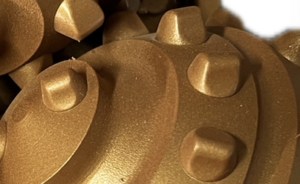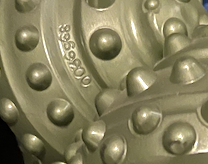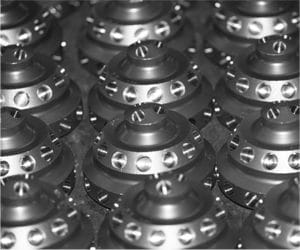Button Bits
Button Bits for Hard Rock Drilling
Button bits are essential for hard rock drilling and are extensively used by oilfield, water well, HDD, and geothermal drillers.
Button bits offer several advantages over PDC drill bits.
- Button bits are less expensive than PDC drill bits
- Button bits can drill through gravels, dolomite, and very hard and abrasive limestone
- Button bits can withstand higher impact
Despite the advantages mentioned above, the PDC drill bit has taken over half the market share of total footage drilled.
Button bits, also known as roller cones, feature rotating cones embedded with tungsten carbide inserts. Tricones, or three-cone bits, are the most common tricone design; however, manufacturers continue to manufacture bits in two-cone and one-cone variations to cater to diverse drilling needs. Explore more about tricone drill bits design here.
Tungsten Carbide Insert Design
Button bit inserts fall into two classifications: Chisel and Conical.
Chisel Inserts
Button bits equipped with chisel inserts drill more aggressively than those with conical inserts. While higher aggressiveness leads to an increased Rate of Penetration (ROP), it also reduces the bit’s durability.
Conical Inserts
Conical inserts drill less aggressively but offer more outstanding durability. Conical button bits are preferred for hard limestones and dolomites.
The IADC Classification System and IADC dull grading system enable drillers, salespersons, and engineers to choose the correct drill bit for the formation to be drilled.
Tungsten Carbide Inserts
Tungsten carbide inserts are individually manufactured and then press-fit into pre-drilled holes in the cone of the bit.
Button Bits vs. PDC
Advantages
- Cost – Smaller initial investment
- Less Impact Damage – Impact is less damaging to the cutting structure
- Better in Hard Rock Formations – The fracturing action of a button bit is better in non-homogeneous rock formations.
- More Control Over Bit – In directional drilling applications, a button bit is easier to control, thereby offering lower torque, greater flexibility on WOB, and a more steady tool face.
***Note: Directional drillers traditionally use button bits because they’re steerable. However, new technology has caused the pdc bit to outperform.
Why?
Particular emphasis has been placed on the pdc cutter and design aspects of the pdc bit.
Disadvantages
- Lost Cones – Because tricones have moving parts, there is always the risk of losing a cone in the hole.
- Lower ROP – The shearing action of a PDC bit is more efficient, resulting in higher ROP.
- Higher Cost Per Foot – Lower ROP results in higher cost per foot. PDC bits can be repaired and run multiple times, while tricones cannot.
- Lower Bit Life – PDC bits have a longer life than tricones.
Button Bits vs. Tooth Bits
Advantages
When drilling wells, drillers often opt for button bits over tooth bits due to several distinct advantages:
- Enhanced Durability: Button bits, featuring tungsten carbide inserts, boast superior durability and resistance to wear compared to tooth bits.
- Higher Penetration Rates: Button bits facilitate higher penetration rates, allowing drillers to complete well-drilling projects more efficiently.
- Improved Stability and Control: Button bits offer enhanced stability and control, which is particularly beneficial in directional drilling applications, ensuring precise drilling performance.
- Cost-Effectiveness: Button bits provide a cost-effective solution without compromising quality or performance, making them a preferred choice for drillers seeking efficiency and economy in well-drilling projects.
Disadvantages
While button bits are widely favored in well drilling, there are scenarios where drillers opt for tooth bits due to specific advantages:
- Versatility in Soft Formations: Tooth bits excel in softer formations where their design allows for effective penetration and removal of materials.
- Lower Initial Cost: Tooth bits typically have a lower initial cost compared to button bits, making them a more economical choice for some drilling projects.
- Ease of Maintenance: Tooth bits are often easier to maintain and repair, reducing downtime and costs associated with equipment maintenance.
- Prevention of Clogging: In certain formations, tooth bits may be less prone to clogging with drilling debris, ensuring continuous drilling progress.
While button bits offer durability and efficiency, tooth bits remain a viable option for drillers facing specific geological challenges or seeking cost-effective solutions for their well-drilling projects.





